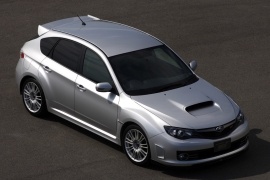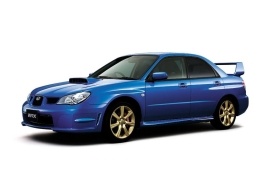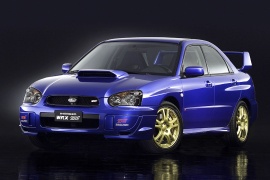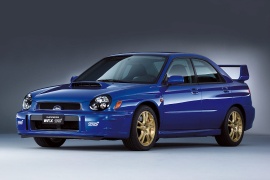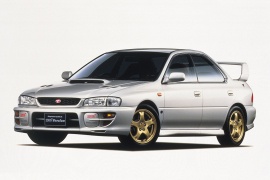SUBARU Impreza WRX STi Models/Series Timeline, Specifications & Photos
First production year: 1998
Engines: Gasoline
Subaru took the world by surprise when it introduced the Impreza WRX STI at the 2007 Tokyo Motor Show, but not exactly in a good way.
Since the beginning of the Impreza saga, it was available as a sedan or station wagon, but the 2007 model was the first revealed as a hatchback.
Before this generation, the carmaker didn’t pay too much attention to the design of its car, but for the 2008 model, it was a different story. Subaru pushed its design department to create something special, and special they did. Its rounded shapes and sharp angles on the headlights, plus the narrow grille above the bumper, made the car looks aggressive. The scoop on the hood was functional and, also, traditional for the WRX STI. On the lower part, in the apron, the carmaker installed fog lights. Usually, the former STI versions didn’t have that. Unlike the rest of the Impreza range, it featured widened front and rear fenders in a tuning-like style. At the back, on top of the tailgate, the carmaker added a wide wing.
Inside, the materials’ quality was better than before. Its Alcantara-wrapped sport bucket seats at the front and the flat, split-folding bench at the rear gave the customers the sensation that they didn’t buy an empty shell with a motor. The instrument panel received the same layout as its predecessors, with a wide speedometer in the middle flanked by the tachometer on the right and the fuel and coolant temperature gauges on the left.
Under the hood, Subaru installed a turbocharged flat-four engine. The only transmission available was a six-speed manual, which sent the power in all corners via an adjustable center differential.
Also known as the Hawkeye Impreza, the 2005 WRX STI version was the ultimate street-racer worldwide.
By 2005, Subaru already had a huge fan base around the world. Its all-wheel-drive sedan convinced more people that a turbocharged flat-four was quicker than some might expect. Its sudden starts and neck-hurting performance transformed it into a street-racer. The WRX STI was the top-of-the-line version, and, in good hands, it was a hard-to-beat car. The Japanese engineers geared the transmission so it could get better quarter-mile times than more powerful cars.
The redesigned 2005 Impreza WRX STI featured swept-back headlights that resembled hawk eyes and a three-part grille that resembled an airplane. Its front bumper sported a lower apron with an integrated rectangular grille for the intercooler. Instead of the fog lights, it featured two body-colored plastic caps with the red Subaru Tecnica International logo. The STI version featured a spoiler on the upper side of the rear windscreen and a wing on the trunk as a specific accessory.
Inside, the carmaker kept the sport bucket seats with high bolstering and integrated headrests. In the instrument cluster, the tachometer took the center stage flanked by the speedometer on the right dial and the fuel and coolant-temperature gauges on the left dial. The STI was available in only one trim level. The car sported the sound system on the upper side and the climate control dials on the lower side on the center stack.
Unlike the rest of the Impreza range, the STI version featured a six-speed manual and an adjustable front and rear torque distribution dial for selected markets. Its flat-four engine provided a claimed 280 hp.
When the 2000 Impreza showed up, its fans were shocked in front of the "bug-eyed" headlamps, making the car look ugly enough, so dealers had to cut prices to sell it. Then, the 2003 model arrived.
Subaru Impreza WRX STI was the hero-car. The underdog could make more expensive cars run away from the drag-strips, unable to beat the all-wheel-drive rally car. Because that's what it was: a rally car disguised in street clothes. Its close-ratio gearbox, the all-wheel-drive system, and the punchy engine made the car jump from the starting line like no other. Even its main rival, the Mitsubishi Evo, was slower than it.
The 2003 Impreza WRX STI was considered the last brutal Impreza that could satisfy its drivers and put a big smile on their faces. Its new headlights were more sweeping, which made them look narrower. Subaru cut a slice from the front bumper to accommodate the round inside high-beam lamp. Its black, trapezoidal grille sported the Subaru badge in the middle and the three red letters from STI – Subaru Tecnica International. On the hood, the carmaker installed a wide air-intake for the intercooler. From its sides, the flared arches were filled by the 17" light-alloy golden wheels, and, in the back, a massive wing stood proud on top of the trunk. Subaru redesigned the taillights as well, but few could notice that.
Inside, the 2003 Subaru received better materials and a new design for the center stack, which sported an enhanced audio system and the HVAC controls. Subaru installed standard air-conditioning and power windows for the frameless doors.
Besides the aesthetic changes, the STI version featured a 2.0-liter flat-four boxer engine that provided 265 hp to the symmetrical all-wheel-drive system via a six-speed gearbox.
Subaru Technica International. These three letters added to the back of the Impreza WRX made a huge difference known by petrolheads and, especially, by those who loved rallies.
Noriyuki Koseki raced in the World Rally Championship with Subaru vehicles, and it noticed that there was room for improvement. That's why he started the STI. It aimed to get better results for the Japanese carmaker. Soon, he started to work closely with the carmaker and tuned the racing vehicles. In 2000, Subaru asked STI to built a street version for the already known Subaru Impreza WRX. And that's what it did.
While the engineers burned the midnight oil, Subaru's designers seemed to be off-duty, and the car's design was one of the most unsuccessful ones in the brand's history. Its big, round headlights attracted the nickname "bugeye." Instead of round fog-lights in the bumper, the carmaker installed two lids with the STI red lettering on them. In the back, the engineers installed a ridiculously big wing on the trunk lid.
Inside, the race-inspired bucket seats were tight and offered great side support during hard cornering. And the Impreza was mastering that. Due to the slim front seats, there was enough room in the back for three adults. Although not too many people bought the STI for the comfort of the rear seats. The instrument cluster was simple and featured only the regular dials for the speedometer, tachometer, fuel gauge, and temp-level. The center dial, which was for the rev-counter, displayed the STI red letters.
Under the hood, the engineers installed a 2.0-liter flat-four engine. It was helped by a turbocharged to offer 265 hp. It was paired to a 6-speed manual and sent the power to all four wheels via a unique Subaru tuned system.
It was one of the iconic cars in the World Rally Championship, a champion of the hearts and a dream-car for many rally-enthusiasts. The Impreza WRX STI was a true rally-car built for the road.
The STI came from Subaru Technica International, which was the motorsport division of the Subaru. It developed a high-performance vehicle underneath a bland looking car. It was a form follow function but in a Japanese way.
With a very few exceptions, such as the SVX, Subaru was never praised for the design of its cars. The 1998 Impreza WRX STI was no exception. Its horizontal headlights and small grille above the bumper were bland looking. The big bumper and apron featured plastic, screwed-in, caps instead of fog lights. A big intercooler was seen through the lower grille. In the back, a bigger than usual wing improved the sporty image.
The interior was not impressive. Just a regular dashboard, normal dials on the instrument cluster, a steering wheel, and a gear-stick on the floor. The sport-bucket seats were a clue that the car was more capable than it looked.
The 1998 Impreza STI was fitted with a turbocharged flat-four engine that produced almost 280 hp. It was very fast at any time standards. A 0-100 kph (0-62 mph) in 5.5 seconds was proof. Its all-wheel-drive system was one of the best in the world, if not the best at the time of its launch. The independent suspension in all corners enhanced the comfort and cornering speed as well.
